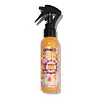What's inside
What's inside
 Key Ingredients
Key Ingredients

No key ingredients
 Benefits
Benefits

 Concerns
Concerns

 Ingredients Side-by-side
Ingredients Side-by-side

Water
Skin ConditioningPrunus Amygdalus Dulcis Oil
Skin ConditioningPolyquaternium-37
Cetearyl Alcohol
EmollientPropylene Glycol Dicaprylate/Dicaprate
EmollientVp/Dmapa Acrylates Copolymer
Vp/Va Copolymer
Argania Spinosa Kernel Oil
EmollientMel
EmollientSodium Benzoate
MaskingPEG-40 Hydrogenated Castor Oil
EmulsifyingPPG-1 Trideceth-6
Skin ConditioningPropylene Glycol
HumectantParfum
MaskingHydrolyzed Wheat Protein
Skin ConditioningPanthenol
Skin ConditioningCitric Acid
BufferingDipropylene Glycol
HumectantIsopropyl Myristate
EmollientBenzalkonium Chloride
AntimicrobialPropolis Cera
AntiseborrhoeicTriethyl Citrate
MaskingBenzyl Salicylate
PerfumingCitronellol
PerfumingCoumarin
PerfumingWater, Prunus Amygdalus Dulcis Oil, Polyquaternium-37, Cetearyl Alcohol, Propylene Glycol Dicaprylate/Dicaprate, Vp/Dmapa Acrylates Copolymer, Vp/Va Copolymer, Argania Spinosa Kernel Oil, Mel, Sodium Benzoate, PEG-40 Hydrogenated Castor Oil, PPG-1 Trideceth-6, Propylene Glycol, Parfum, Hydrolyzed Wheat Protein, Panthenol, Citric Acid, Dipropylene Glycol, Isopropyl Myristate, Benzalkonium Chloride, Propolis Cera, Triethyl Citrate, Benzyl Salicylate, Citronellol, Coumarin
 Reviews
Reviews

Alternatives
Ingredients Explained
These ingredients are found in both products.
Ingredients higher up in an ingredient list are typically present in a larger amount.
Citronellol is used to add fragrance/parfum to a product. It is often derived from plants such as roses. In fact, it can be found in many essential oils including geranium, lavender, neroli, and more. The scent of Citronellol is often described as "fresh, grassy, and citrus-like".
Since the Citronellol molecule is already unstable, Citronellol becomes irritating on the skin when exposed to air.
Citronellol is a modified terpene. Terpenes are unsaturated hydrocarbons found in plants. They make up the primary part of essential oils.
Citronellol is not able to be absorbed into deeper layers of the skin. It has low permeability,
Citronellol is also a natural insect repellent.
Learn more about CitronellolCoumarins are a group of substances found naturally in plants. There are over 1300 types of coumarins identified. It has a natural vanilla scent.
Coumarin is an identified EU known allergy, meaning it may cause an allergic reaction when applied to the skin.
In many countries, coumarin is banned as a food additive. However, it can be found in soaps, tobacco products, and some alcohol drinks.
Plants use coumarins as a chemical defense. Some plants that have coumarins include lavender, tonka beans, and yellow clovers.
Learn more about CoumarinParfum is a catch-all term for an ingredient or more that is used to give a scent to products.
Also called "fragrance", this ingredient can be a blend of hundreds of chemicals or plant oils. This means every product with "fragrance" or "parfum" in the ingredients list is a different mixture.
For instance, Habanolide is a proprietary trade name for a specific aroma chemical. When used as a fragrance ingredient in cosmetics, most aroma chemicals fall under the broad labeling category of “FRAGRANCE” or “PARFUM” according to EU and US regulations.
The term 'parfum' or 'fragrance' is not regulated in many countries. In many cases, it is up to the brand to define this term.
For instance, many brands choose to label themselves as "fragrance-free" because they are not using synthetic fragrances. However, their products may still contain ingredients such as essential oils that are considered a fragrance by INCI standards.
One example is Calendula flower extract. Calendula is an essential oil that still imparts a scent or 'fragrance'.
Depending on the blend, the ingredients in the mixture can cause allergies and sensitivities on the skin. Some ingredients that are known EU allergens include linalool and citronellol.
Parfum can also be used to mask or cover an unpleasant scent.
The bottom line is: not all fragrances/parfum/ingredients are created equally. If you are worried about fragrances, we recommend taking a closer look at an ingredient. And of course, we always recommend speaking with a professional.
Learn more about Parfum